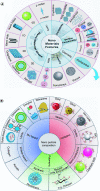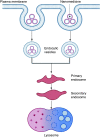A promising RNA nanotechnology in clinical therapeutics: a future perspective narrative review
- PMID: 37621841
- PMCID: PMC10445585
- DOI: 10.2144/fsoa-2023-0067
A promising RNA nanotechnology in clinical therapeutics: a future perspective narrative review
Abstract
Nanotechnology is the use of materials that have unique nanoscale properties. In recent years, nanotechnologies have shown promising results for human health, especially in cancer treatment. The self-assembly characteristic of RNA is a powerful bottom-up approach to the design and creation of nanostructures through interdisciplinary biological, chemical and physical techniques. The use of RNA nanotechnology in therapeutics is about to be realized. This review discusses different kinds of nano-based drug delivery systems and their characteristic features.
Keywords: RNA nanotechnology; endosomal escape; endosomes; nanoparticles; physicochemical properties; ribose nucleic acid.
Plain language summary
A branch of nanotechnology called RNA nanotechnology involves designing, studying, and utilizing synthetic structures based on RNA. This review discusses different kinds of nano-based drug delivery systems and their characteristic features. It aims to provide an overview of nanoparticles as a delivery system for gene therapy to treat diseases such as cancer. In order to enhance nanoparticle efficacy, these systems should be designed with this in mind in order to develop and test delivery systems rationally and scientifically.
© 2023 Doha El-Sayed Ellakwa.
Conflict of interest statement
Conflicts of interest disclosure The authors declare that there are no conflicts of interest present.
Figures



Similar articles
-
A review of RNA nanoparticles for drug/gene/protein delivery in advanced therapies: Current state and future prospects.Int J Biol Macromol. 2025 Mar;295:139532. doi: 10.1016/j.ijbiomac.2025.139532. Epub 2025 Jan 5. Int J Biol Macromol. 2025. PMID: 39765293 Review.
-
Detecting and destroying cancer cells in more than one way with noble metals and different confinement properties on the nanoscale.Acc Chem Res. 2012 Nov 20;45(11):1854-65. doi: 10.1021/ar2003122. Epub 2012 Apr 30. Acc Chem Res. 2012. PMID: 22546051 Free PMC article.
-
Nanotechnology: an evidence-based analysis.Ont Health Technol Assess Ser. 2006;6(19):1-43. Epub 2006 Nov 1. Ont Health Technol Assess Ser. 2006. PMID: 23074489 Free PMC article.
-
Addressing the in vivo delivery of nucleic-acid nanostructure therapeutics.Adv Drug Deliv Rev. 2023 Aug;199:114898. doi: 10.1016/j.addr.2023.114898. Epub 2023 May 23. Adv Drug Deliv Rev. 2023. PMID: 37230305 Review.
-
Cellular Trafficking of Nanotechnology-Mediated mRNA Delivery.Adv Mater. 2024 Mar;36(13):e2307822. doi: 10.1002/adma.202307822. Epub 2023 Dec 12. Adv Mater. 2024. PMID: 37929780 Review.
Cited by
-
RNA four-way junction (4WJ) for spontaneous cancer-targeting, effective tumor-regression, metastasis suppression, fast renal excretion and undetectable toxicity.Biomaterials. 2024 Mar;305:122432. doi: 10.1016/j.biomaterials.2023.122432. Epub 2023 Dec 21. Biomaterials. 2024. PMID: 38176263 Free PMC article.
-
Mitochondrial dysfunction as a key player in aggravating periodontitis among diabetic patients: review of the current scope of knowledge.Naunyn Schmiedebergs Arch Pharmacol. 2025 Apr 24. doi: 10.1007/s00210-025-04025-x. Online ahead of print. Naunyn Schmiedebergs Arch Pharmacol. 2025. PMID: 40272516 Review.
-
Strategies and Recent Advances on Improving Efficient Antitumor of Lenvatinib Based on Nanoparticle Delivery System.Int J Nanomedicine. 2024 Jun 10;19:5581-5603. doi: 10.2147/IJN.S460844. eCollection 2024. Int J Nanomedicine. 2024. PMID: 38882543 Free PMC article. Review.
-
A study to determine the effect of nano-selenium and thymoquinone on the Nrf2 gene expression in Alzheimer's disease.Future Sci OA. 2025 Dec;11(1):2458434. doi: 10.1080/20565623.2025.2458434. Epub 2025 Jan 31. Future Sci OA. 2025. PMID: 39887156 Free PMC article.
References
-
- Dubey A, Shetty A, Ravi G, Kiritkumar MC, Prabhu P, Hebbar S et al. Development and investigation of a novel solid self-nanoemulsifying system loaded with hydrochlorothiazide for the treatment of hypertension. International Journal of Pharmaceutical Investigation 8(2), 83–91 (2018).
-
- Attama A, Schicke B, Paepenmüller T, Müller-Goymann C. Solid lipid nanodispersions containing mixed lipid core and a polar hetero-lipid: characterization. European Journal of Pharmaceutics and Biopharmaceutics 67(1), 48–57 (2007). - PubMed
Publication types
LinkOut - more resources
Full Text Sources
